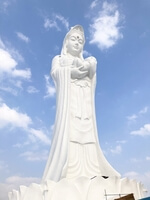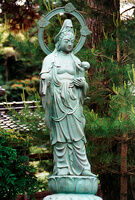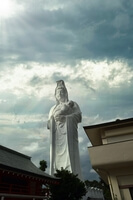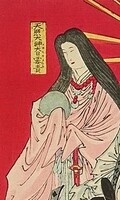懺悔文 Confession; Self-Mirroring in serenity
Accepting your own faults may not be always easy.
Self criminalization is never fun, but this is not about intoxicating
your heart with ( a sense of ) guilt.
This is more of feeling gratitude for knowing we are all allowed to exist as who we are.
Confession, in essense, can be treated as a mental detox, to let our hearts and souls breathe in hope.
|
|
懺悔文 chàn huǐ wén This song repeat the mantra 5 times. |
往昔所造諸悪業
wǎn xí suǒ zào zhū è yè All the unwholesome karma Created by me, 皆由無始貪瞋癡 jiē yóu wú shǐ tān chēn chī Arising from beginningless Greed, hatred and delusion 従身語意之所生 cóng shēn yǔ yì zhī suǒ shēng Expressed through My body, speech, and mind 一切我今皆懺悔 yí qiè wǒ jīn jiē chàn huǐ I hereby regret And repent them all |



The affectionate mother Kannon, the Goddess of Mercy at Aizu / Rurikoji / Naritasan Kurume Temple
The song is covered by a Taiwanese Buddhist singer, Chyi Yu, and I really like her version.
It is mostly because her singing voice streams like a river or clouds carried by gentle wind.
Her divine tone also makes it sound like it's Goddess 観音( Kannon in Japanese ) herself who's singing this for us, bringing another aspect
of Buddha's infinite love to the mantra.
Merciful 観 ( watch ) 音 ( sound ) listens to peoples' cries in agony.
Kannon is argued to be originally male or above gender, but in many places is accepted as a goddess ( or more precisely, female "Buddha-to-be" ).
Kannon has quite a few expressions, and one of which is that of a mother, holding a baby.
She overlaps with an image of the Virgin Mary a lot.
Historically speaking, it was regarded as such in Christians in Japan
during Edo period ( 17th-19th century ) when Christianity was not officially accepted, and people interpreted Christianity in Buddhist way.

Painting by William Adolphe Bouguereau, "The Madonna of the Lilies" (1899)
Now it was quite easy to find a Christian counterpart.
The song's message is pretty simple, and easy to grasp.
Beautiful images, but life is just a little too busy here.
Just like Jesus's love sung in this song, Buddha's light ( Buddha-nature ) is conceived to reside in people,
so people are encouraged to find it inside themselves, not the outside, while every creature
other than humans is considered to be equally blessed with Buddha's light.
There's this famous teaching that nature's way, such as bird songs, water and wind sounds all teaches Buddha's wisdom. This beautifully fits the video images of the song above.

Below is yet another beautiful piece of art from Queen, which is gospel-like.
Some interpreted this "We're all God's people" as
a message that people are all God's, no
matter what religion they believe in/ belief they have, and I agree.
Thank you Queen for this song. I believe this message is mighty and universal.
If there is a church that lets people sing a gospel song like this, I would be really curious. |



A shrine priest praying in front of a sacred mirror / Amaterasu, the greatest goddess of the sun, holding her sacred mirror
Photo by Chris 73 / Part of Chikanobu Yoshu's "A Mirror of Japanese Nobility" (1887)
Finally, let's take a look at Japanese folk religion, Shinto.
Amaterasu, the sun goddess's attribute is a mirror. When her grandson descended to the earth from Heaven to rule the world, she handed the sacred mirror to him and asked to enshrine it by treating it as her soul, saying "when you look into this mirror, you shall see me".
One theory has it that the Japanese word mirror, 鏡 Kagami, when removing Ga( =我=ego/self ), becomes
kami( =神=god ), implying that through self-reflection you'll get closer to God, by becoming self-less.
So, one day, if you see something bigger than yourself in a mirror, what would it feel like?
As for myself, I'm still the one whose face is swayed by her daily mood too often, who struggles to have a more unhindered, better perspective of everything,
but I sure will keep trying.
That's it for a little note about self-reflection for now. I'll make another post to talk about religion, belief in general. Yes, in Steo's song "I believe" post!

Painting by John William Waterhouse "Echo and Narcissus" (1903)
What does he see? Of course nothing but himself! One of the funniest yet saddest paintings ever.
Leave a Comment
This page's URL: ""
Photo by PabloHeimplatz on Unsplash
